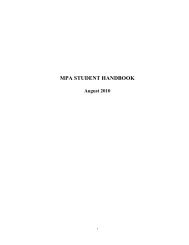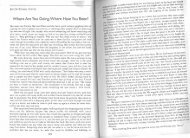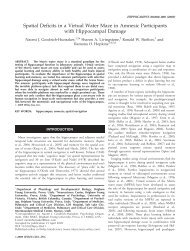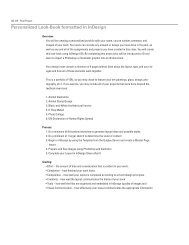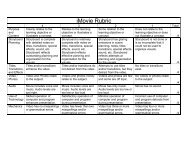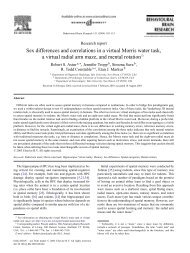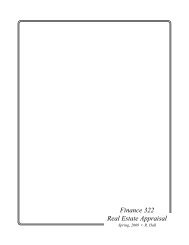Currency substitution in selected African countries - Emerald
Currency substitution in selected African countries - Emerald
Currency substitution in selected African countries - Emerald
Create successful ePaper yourself
Turn your PDF publications into a flip-book with our unique Google optimized e-Paper software.
4.1 Long-run analysis<br />
Prior to the estimation of model (5), we need to check the stationarity of each series<br />
used here. Thus, to test whether the series are stationary or not a variety of unit root<br />
tests are performed. We use Dickey-Fuller tests, Augmented Dickey-Fuller and<br />
different variations of Phillips-Perron tests on level and first difference for each series.<br />
We f<strong>in</strong>d that we have a comb<strong>in</strong>ation of I(0) and I(1) variables <strong>in</strong> the money demand<br />
equation of each country. For Egypt, ln(m 2 ), i, and Dp * are I(1) whereas ln ( y) and Dp<br />
are I(0). For Ghana, ln (m 2 ), ln ( y), i and Dp * are I(1), and Dp is I(0); for Kenya,<br />
Morocco, South Africa and Tunisia, ln(m 2 ), ln( y), i and Dp * are I(1) while Dp is I(0);<br />
and for Nigeria and Zambia ln(m 2 ), ln( y), i, Dp and Dp * are all I(1)[9].<br />
We <strong>in</strong>vestigate the existence of a long-run relationship between real money<br />
balances, real <strong>in</strong>come, <strong>in</strong>terest rate, expected <strong>in</strong>flation and expected exchange rate<br />
depreciation. In Table II, we report the l-max and l-trace statistics proposed by<br />
<strong>Currency</strong><br />
<strong>substitution</strong><br />
623<br />
Country Home currency Anchor currency<br />
Egypt Pound US dollar<br />
Ghana New Cedi CFA franc<br />
Kenya Shill<strong>in</strong>g South Africa rand<br />
Morocco Dirham Egyptian pound<br />
Nigeria Naira CFA franc<br />
South Africa Rand US dollar<br />
Tunisia D<strong>in</strong>ar Egyptian pound<br />
Zambia Kwacha South Africa rand<br />
Table I.<br />
Home and anchor<br />
currencies<br />
Number of co<strong>in</strong>tegrat<strong>in</strong>g vectors<br />
Country Test statistic r # 0 r # 1 r # 2 r # 3 r # 4<br />
Egypt l-trace 154.636 75.076 33.712 10.981 0.155<br />
p ¼ 3 l-max 79.559 41.364 22.731 10.826 0.155<br />
Ghana l-trace 137.066 67.053 31.288 11.471 5.148<br />
p ¼ 3 l-max 70.012 35.766 19.817 6.323 5.148<br />
Kenya l-trace 93.469 60.590 31.256 8.971 1.297<br />
p ¼ 8 l-max 32.879 29.333 22.285 7.675 1.297<br />
Morocco l-trace 104.981 48.127 20.219 9.192 0.313<br />
p ¼ 4 l-max 56.854 27.908 11.027 8.879 0.313<br />
Nigeria l-trace 113.281 64.735 21.436 9.538 0.396<br />
p ¼ 5 l-max 48.546 43.299 11.897 9.142 0.396<br />
South Africa * l-trace 143.383 91.202 51.524 31.185 11.725<br />
p ¼ 8 l-max 52.181 39.678 20.339 19.461 11.725<br />
Tunisia l-trace 79.689 41.806 13.873 4.283 1.479<br />
p ¼ 3 l-max 37.882 27.933 9.590 2.804 1.479<br />
Zambia l-trace 116.707 44.664 16.492 3.815 0.478<br />
p ¼ 3 l-max 72.042 28.172 12.677 3.337 0.478<br />
5 percent critical values: l-trace 69.819 47.856 29.797 15.495 3.841<br />
l-max 33.877 27.584 21.132 14.265 3.841<br />
5 percent critical values * l-trace 88.804 63.876 42.915 25.872 12.518<br />
l-max 38.331 32.118 25.823 19.387 12.518<br />
Note: p is the number of lags suggested by AIC<br />
Table II.<br />
l-trace and l-max test<br />
statistics



